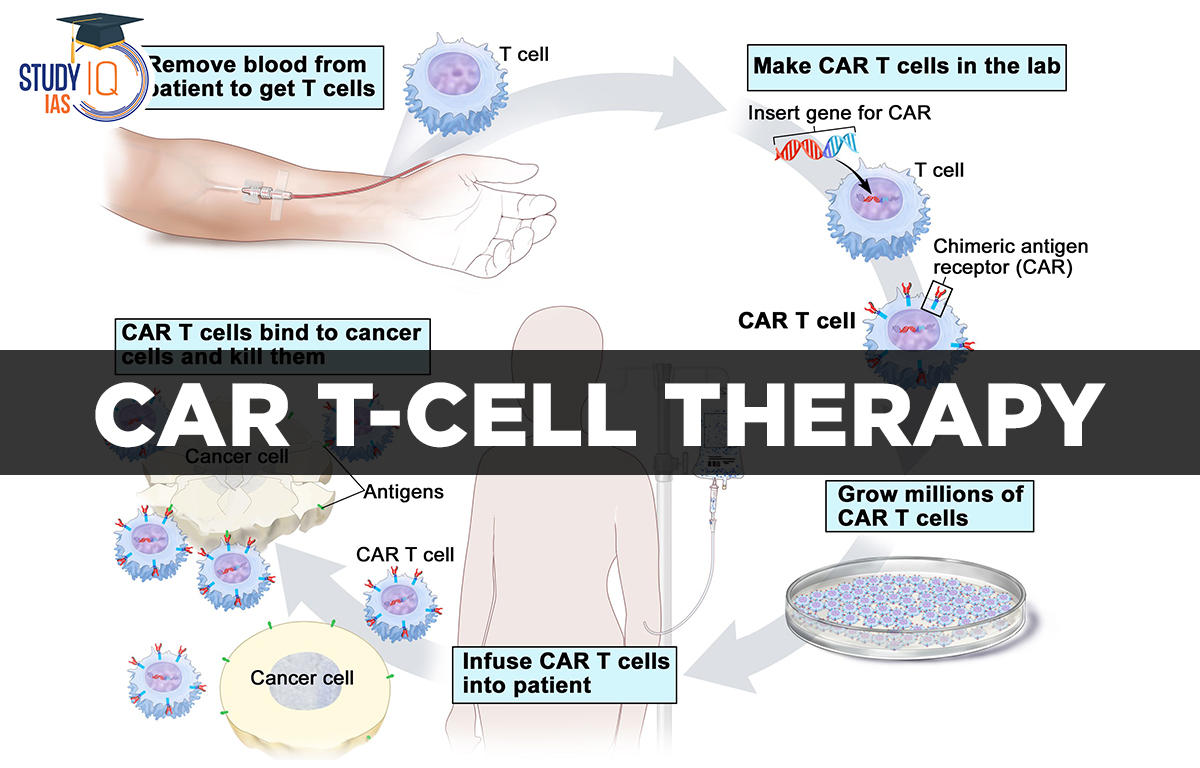Table of Contents
Context: Globally, there is a growing interest in CAR T-cell therapy, a new form of systemic therapy for cancer treatment.
What are the Major forms of Cancer Treatment?
- The three major forms of treatment for any cancer are:
- surgery (removing cancer),
- radiotherapy (delivering ionising radiation to the tumour), and
- systemic therapy (administering medicines that act on the tumour).
- Surgery and radiotherapy have been refined significantly over time – whereas advances in systemic therapy have been unparalleled.
What are T Cells?
- T cells, also known as T lymphocytes, are a type of white blood cell that play a central role in the immune response.
- Significance: T cells play a crucial role in the adaptive immune response, which is the part of the immune system that is capable of recognizing and responding to specific pathogens or abnormal cells.
- Production: T cells are produced in the bone marrow and mature in the thymus gland.
- Important types of T cells:
- Helper T cells: These cells play a crucial role in coordinating the immune response.
- Cytotoxic T cells: These cells play a key role in destroying cells that are infected with viruses or cancer cells.
- T regulatory cells (Tregs): These cells play a crucial role in maintaining immune tolerance and preventing autoimmunity.
Evolution of Systemic Therapy in Cancer Treatment
- Chemotherapy: Systemic therapy’s earliest form was chemotherapy: when administered, it preferentially acts on cancer cells because of the latter’s rapid, unregulated growth and poor healing mechanisms.
- Disadvantages: Chemotherapeutic drugs have modest response rates and significant side effects as they affect numerous cell types in the body.
- Immunotherapy: The next stage in its evolution was targeted agents, a.k.a. immunotherapy: the drugs bind to specific targets on cancer or in the immune cells that help the tumour grow or spread.
- Disadvantages: This method often has fewer side effects as the impact on non-tumour cells is limited. However, it is effective only against tumours that express these targets.
- CAR T-cell therapy: Chimeric antigen receptor (CAR) T-cell therapies represent a quantum leap in the sophistication of systemic cancer treatment.
What is CAR T-cell Therapy?
- CAR T-cell therapy is a type of immunotherapy used to treat certain types of cancer, such as leukemia and lymphoma.
- It involves removing a patient’s T cells (a type of immune cell) and modifying them in a laboratory to produce special cells known as chimeric antigen receptor (CAR) T cells.
- The modified T cells are then infused back into the patient’s bloodstream, where they can recognize and attack cancer cells that express specific targets, or antigens, on their surface.
- Because the CAR T cells are a product of the patient’s own immune system, they are less likely to cause side effects compared to other forms of cancer therapy.
- Procedure for the CAR T-cell therapy:

- Current Applications of CAR T-cell therapy:
- As of today, CAR T-cell therapy has been approved for leukaemias (cancers arising from the cells that produce white blood cells) and lymphomas (arising from the lymphatic system).
- CAR T-cell therapy is also presently used among patients with cancers that have returned after initially successful treatment or who haven’t responded to previous combinations of chemotherapy or immunotherapy.
- Efficacy: Its response rate is variable. In certain kinds of leukaemias and lymphomas, the efficacy is as high as 90%, whereas, in other types of cancers, it is significantly lower.
- Side effects: the potential side effects are also significant, and associated with
- cytokine release syndrome (a widespread activation of the immune system and collateral damage to the body’s normal cells) and
- neurological symptoms (severe confusion, seizures, and speech impairment).
- Other challenges associated:
- Preparation: The difficulty of preparing CAR T-cell therapies has been a major hindrance to their widespread use.
- Affordability: Critics argue that developing CAR T-cell therapy in India may not be cost-effective as it will still be unaffordable for most people.





















 WhatsApp
WhatsApp